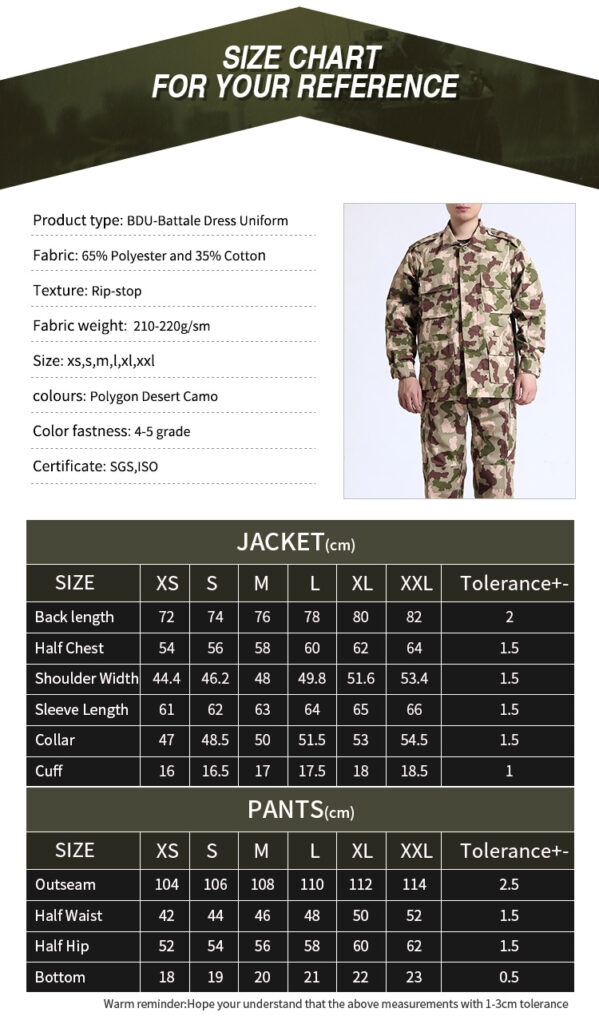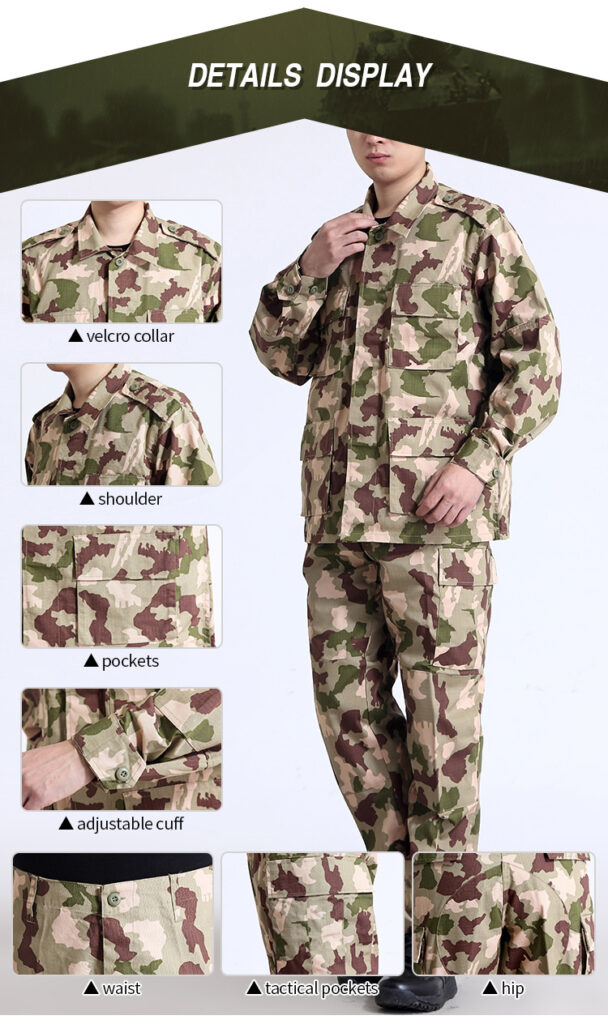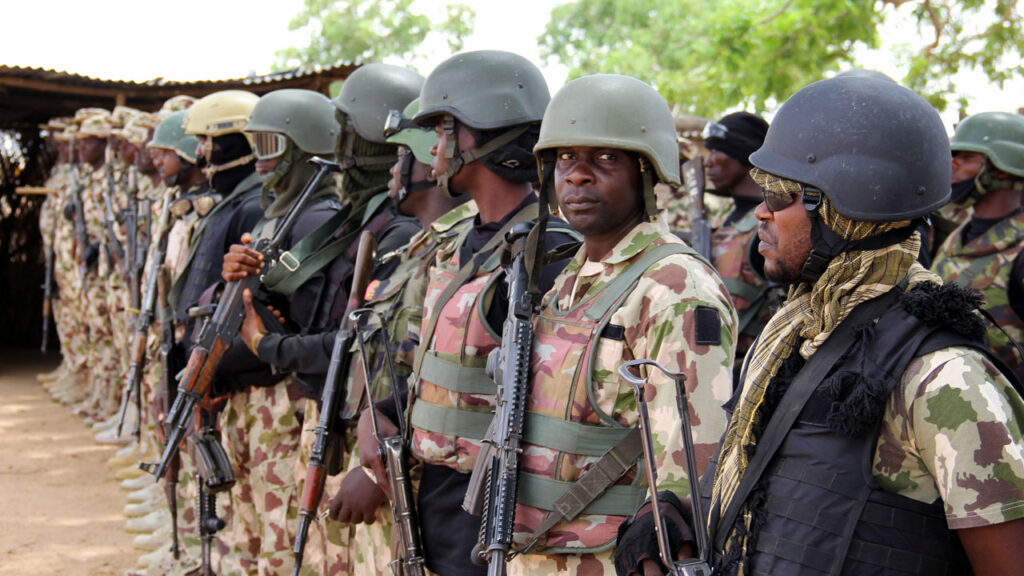When it comes to equipping a military force, the quality and specifications of the uniforms are as crucial as any piece of tactical equipment. If you’re tasked with the procurement of Nigeria Army uniforms in bulk, understanding the key factors to consider is essential. This guide will help you navigate the complexities of military uniform procurement, ensuring you get the best value and the right products for your needs.
What are the essentials to consider when buying Nigeria Army uniforms in bulk?
When purchasing military uniforms, focus on authenticity, material quality, and supplier reliability. Authentic uniforms comply with military standards and bear the correct insignia and patterns, which are crucial for the identity and uniformity of the service members.
Authorized Suppliers and Manufacturers
Work with reputable suppliers and manufacturers that are authorized to produce Nigeria Army uniforms. Look for companies with a proven track record and experience in supplying military apparel to the Nigerian Armed Forces or other legitimate government agencies.1 2

Camouflage Pattern Authenticity
Ensure the camouflage patterns used on the uniforms are the official M14 Arid and M14 Woodland patterns adopted by the Nigerian Army in 2014. Avoid unauthorized or counterfeit patterns that could raise security concerns or violate regulations.

Material Quality and Durability
Nigerian Army uniforms should be made from high-quality, durable materials that can withstand the rigors of military operations and environmental conditions. Look for fabrics that offer breathability, moisture-wicking, and resistance to fading, tearing, and abrasion.2

Proper Sizing and Fit
Obtain accurate sizing information and measurements to ensure the uniforms fit properly for optimal comfort and Obtain accurate sizing information and measurements to ensure the uniforms fit properly for optimal comfort and mobility. Nigerian Army uniform suppliers should offer a range of sizes to accommodate different body types and builds.2

Quality Control and Inspection
Inquire about the supplier’s quality control processes and inspection procedures to ensure the uniforms meet the required specifications and standards before delivery. This can help identify and address any defects or issues before the bulk order is finalized.2

Compliance with Regulations
Make sure the supplier is familiar with and adheres to any relevant Nigerian Army regulations or guidelines regarding uniform design, materials, and production processes. This can help avoid potential issues with non-compliance.
By considering these factors, procurement officers and decision-makers can make informed choices when purchasing Nigeria Army uniforms in bulk, ensuring they receive authentic, high-quality products that meet the needs and standards of the Nigerian Armed Forces.
Related Questions
1- What type of uniform is used in the Nigerian military?
- The Nigerian Armed Forces (Army, Navy, Air Force) introduced new indigenous camouflage patterns called M14 Arid and M14 Woodland in 2014 to replace previously used U.S. woodland and desert patterns.6
- The M14 Arid pattern utilizes khaki, stone green, chocolate brown colors and is used in northern arid regions.6
- The M14 Woodland uses forest green, khaki drab, reddish brown, and near black colors for southern tropical/savanna areas.6
- Other uniforms used include blue-grey pixelated patterns by the Air Force, and the Navy Special Boat Service wears a blue camouflage based on the Chinese Navy Type 87 design.

2- Who designed the Nigerian military uniform?
- The new M14 Arid and Woodland camouflage patterns were designed by the Nigerian Army Tailoring Department in Yaba, Lagos.5
- This allowed the patterns to be produced under tight government control to prevent unauthorized use.
3- Does the Nigerian Army have special forces?
- The Army has special forces elements.
- These special forces have been documented wearing
4- What are the different types of uniforms used by the Nigerian military
- In 2014, the Nigerian Armed Forces introduced new indigenous camouflage patterns called M14 Arid and M14 Woodland to replace previously used U.S. woodland and desert patterns.
- The M14 Arid pattern uses colors like khaki, stone green, and chocolate brown for arid northern regions.
- The M14 Woodland pattern features forest green, khaki drab, reddish brown, and near-black colors for southern tropical/savanna areas.

- Prior to the M14 patterns, Nigerian forces widely used the U.S. 4-color woodland (M81) camouflage, especially in the south.
- The U.S. 3-color desert camouflage pattern was also used for a time in northern arid regions.

- Nigerian military personnel serving in the Darfur region of Sudan wore the British desert DPM camouflage pattern around 2011.

- The Nigerian Navy Special Boat Service (SBS) adopted a version of the Chinese Navy Type 87 blue camouflage design.
- The Nigerian Air Force personnel wear a blue-grey pixelated camouflage pattern.
- Ceremonial/Dress Uniforms 9
- For ceremonial occasions, the Nigerian Army wears a peaked cap, dark green tunic with patrol collar, and light-colored trousers.

